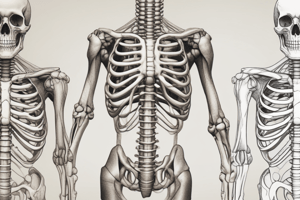Podcast
Questions and Answers
What is the primary function of the manubrium?
What is the primary function of the manubrium?
- To connect to the first rib (correct)
- To provide a point of attachment for the pectoralis major muscle
- To form the upper part of the rib cage
- To protect the heart and major blood vessels
Which of the following is NOT a function of the sternum?
Which of the following is NOT a function of the sternum?
- Support for the ribs
- Muscle attachment
- Production of red blood cells (correct)
- Protection of the heart and major blood vessels
What is the term for a congenital deformity of the sternum?
What is the term for a congenital deformity of the sternum?
- Sternal fracture
- Pectus excavatum (correct)
- Osteomyelitis
- Sternal infection
What is the term for a fracture of the sternum?
What is the term for a fracture of the sternum?
Which muscle does NOT attach to the sternum?
Which muscle does NOT attach to the sternum?
What is the lower part of the sternum?
What is the lower part of the sternum?
Flashcards are hidden until you start studying
Study Notes
Overview of the Sternum
The sternum, also known as the breastbone, is a long, flat bone located in the center of the chest. It connects the ribs together and forms part of the rib cage.
Structure of the Sternum
The sternum is composed of three parts:
- Manubrium: The upper part of the sternum, which connects to the first rib.
- Body of the sternum: The middle part, which connects to the second to seventh ribs.
- Xiphoid process: The lower part, which is a small, cartilaginous projection that connects to the seventh rib.
Functions of the Sternum
The sternum has several important functions:
- Protection: The sternum helps to protect the heart and major blood vessels in the chest.
- Support: It provides a point of attachment for the ribs, helping to maintain the structure of the rib cage.
- Muscle attachment: The sternum serves as an attachment point for various muscles, including the pectoralis major and the intercostal muscles.
Clinical Importance of the Sternum
The sternum is involved in several medical conditions, including:
- Sternal fractures: Fractures of the sternum can occur due to trauma, such as a car accident or fall.
- Sternal infections: Infections, such as osteomyelitis, can affect the sternum.
- Sternal deformities: Congenital deformities, such as pectus excavatum, can affect the shape and structure of the sternum.
Overview of the Sternum
- The sternum, or breastbone, is a long, flat bone located in the center of the chest, connecting the ribs together and forming part of the rib cage.
Structure of the Sternum
- The sternum consists of three parts: manubrium, body of the sternum, and xiphoid process.
- The manubrium is the upper part, connecting to the first rib.
- The body of the sternum is the middle part, connecting to the second to seventh ribs.
- The xiphoid process is the lower part, a small, cartilaginous projection connecting to the seventh rib.
Functions of the Sternum
- The sternum provides protection for the heart and major blood vessels in the chest.
- It provides support by serving as a point of attachment for the ribs, maintaining the structure of the rib cage.
- The sternum serves as a muscle attachment point for various muscles, including the pectoralis major and intercostal muscles.
Clinical Importance of the Sternum
- Sternal fractures can occur due to trauma, such as a car accident or fall.
- Sternal infections, such as osteomyelitis, can affect the sternum.
- Sternal deformities, such as pectus excavatum, can affect the shape and structure of the sternum, and are often congenital.
Studying That Suits You
Use AI to generate personalized quizzes and flashcards to suit your learning preferences.



